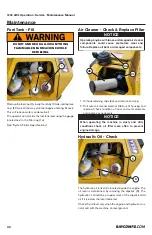
1800 AWL Operation · Service · Maintenance Manual
20
Safety
Pre-Transportation Checks
• Never allow inexperienced drivers to tow the machine.
• When towing, always make sure the tow vehicle ball
hitch and trailer/machine hitch coupler are the correct
matching size and style.
• Always make sure the tow vehicle and the trailer/machine
are on level ground and the wheels are chocked before
connecting or disconnecting.
• Make sure the tow vehicle is of adequate size and has
the towing capacity to safely tow the combined weight
of trailer/machine.
• Never tow a machine while it is running.
• Towing will affect handling, allow for extra stopping
distances. Refer to U-Haul’s “Safe Trailering” Driver
Education Program that is available at this website: http://
www.uhaul.com/guide/index.aspx?equipment=towing-
autotransport
• Make sure the towing eye is at the proper height so the
machine tows level when traveling. A proper amount of
tongue weight is required to allow the machine to tow
properly. Too little tongue weight will result in wandering,
fish-tailing, and/or axle damage.
NOTE: Use caution when backing up. The rear of the RG45T-R
may not be visible from the towing vehicle. It is recommended
to use a spotter outside the vehicle.
• Be aware of the length of the EQUIPMENT while
turning, parking, crossing intersections, and in all driving
situations. When arriving at the work site, do not set up
the EQUIPMENT under a tree that is being pruned,
cut, or worked on.
Important Towing Information
PREVENT WHIPPING by properly loading the auto transport
trailer. Load the heaviest end (engine end) of the vehicle-in-tow
to the FRONT of the trailer. Loading heavier in the rear can
cause the tow vehicle and transport trailer “combination” to
begin WHIPPING, which is violent and uncontrollable sway.
SIDE to SIDE MOTION (SWAY) THAT BEGINS as you
reach a certain speed, will likely become WHIPPING at
higher speeds. If you notice sway beginning SLOW DOWN
IMMEDIATELY by letting off the gas pedal. Then stop to
reload the vehicle-in-tow heaviest end forward as soon as
possible, and remove any cargo from the vehicle-in-tow
(vehicle carried on trailer).
IF WHIPPING or SWAY OCCURS, DO NOT steer. DO
NOT apply your brakes and NEVER speed up. Let off the gas
pedal and hold the steering wheel in a straight-ahead position.
A “combination disturbance” is improper handling, whipping,
sway, over-steering or other deviation of the tow vehicle or
trailer from their intended path, due to one or more causes
(improper loading, steering inputs, excessive speed,
cross winds, passing vehicles, rough roads, etc). IF A
COMBINATION DISTURBANCE OCCURS, DO NOT steer
or brake. Steering or braking during a disturbance can cause
a loss of control or crash.
If a WHEEL GOES OFF THE PAVED ROADWAY, DO NOT
steer sharply and DO NOT brake. Let off the gas pedal and
slow down below 25 mph. Then steer gradually back onto
the roadway. Proceed with caution entering traffic.
Loading Your Combination
NEVER load cargo inside the vehicle-in-tow or on the
trailer. Cargo inside the vehicle-in tow can cause sway or
WHIPPING.
NEVER overload your tow vehicle. Do not exceed the Gross
Vehicle Weight Rating (GVWR) and the Gross Axle Weight
Ratings (GAWR), which are posted on a label inside the
driver’s door opening.
Make sure the trailer is securely attached to the tow vehicle
hitch before loading and unloading.
Keep children and others at least 25 feet away during loading
and unloading.
Slow Down When Towing
AVOID CRASHES by slowing down. Reduce your speed
from what you would normally drive without a trailer under
similar road conditions. The maximum speed is 45 mph
when towing a trailer. Do not exceed any posted speed limit.
DRIVE DEFENSIVELY – anticipate stops, brake early, and
never follow closely.
BEFORE going downhill, slow down and shift the transmission
into a lower gear. DO NOT RIDE BRAKES on downgrades.
Slow down for curves, adverse weather, hazardous road
conditions, road construction and expressway exits.
Before Towing and on the Road
Use the checklist at the end of these instructions before
towing and while on the road.
Make sure your tow vehicle is properly equipped and
maintained. Be sure all tires are inflated properly.
• ALWAYS wear your seat belt.
• DO NOT drive when you are fatigued, sleepy or
distracted. Avoid driving at night.
• NEVER use a cell phone when driving. If you need to
use a cell phone find a safe place to exit the roadway.
• NEVER drive under the influence of alcohol or any
substance that might impair your vision, judgment, or
ability to control the vehicle.































